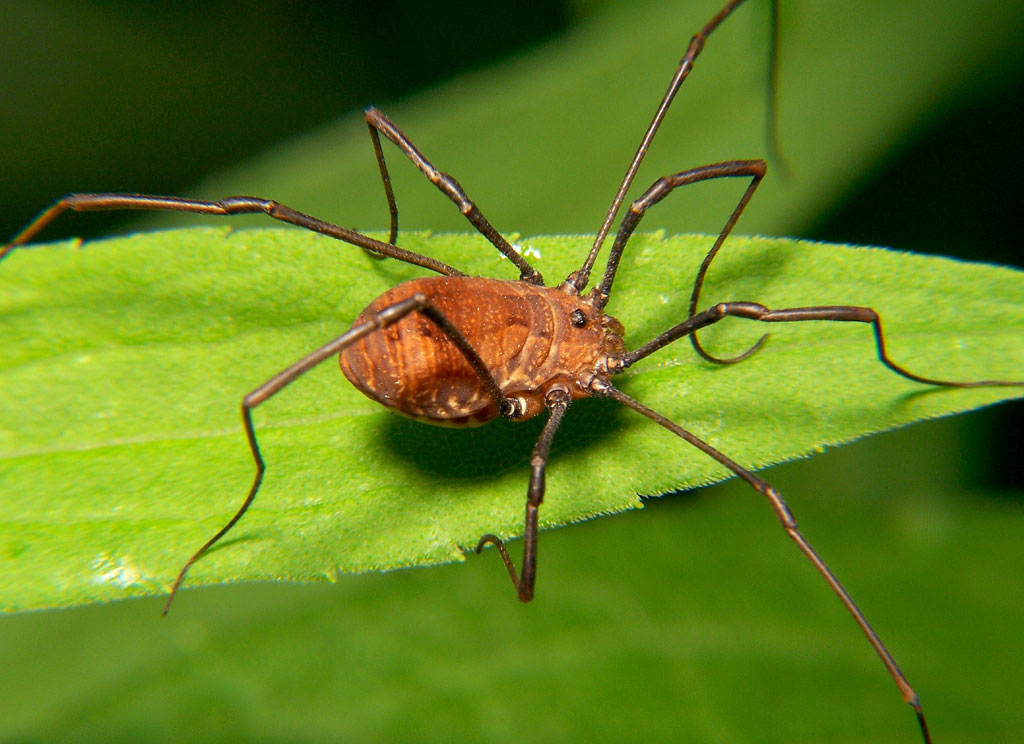- Eupnoi
Taxobox

image_caption = "Hadrobunus grandis "
image_width = 250px
regnum =Animal ia
phylum =Arthropoda
classis =Arachnida
ordo =Opiliones
subordo = Eupnoi
subordo_authority = Hansen & Sørensen, 1904
diversity_link = Eupnoi
diversity = 6 families, > 1,700 species
subdivision_ranks = Superfamilies
subdivision =Caddoidea Phalangioidea The Eupnoi are a suborder of
harvestmen , with more than 200 genera, and about 1,700 described species.They consist of two superfamilies, the Phalangioidea with many long-legged species common to northern temperate regions, and the small group Caddoidea, which have prominent eyes and spiny
pedipalp saut|Shultz, Jeffrey W. & Pinto-da-Rocha, Ricardo (2007): Morphology and Functional Anatomy. In: Pinto-da-Rocha "et al." 2007: 17f] .Examples of this suborder include "
Hadrobunus grandis " (Sclerosomatidae), "Phalangium opilio " and "Dicranopalpus ramosus " (Phalangiidae).Distribution
Caddoidea are mostly found in temperate zones of both hemispheres; however, they are known from the
Palearctic only fromJapan , and fromBaltic amber (about 40 million years old). One species known from Japan is also found inNorth America , where several more species are found. Other species occur in SouthernSouth America ,Venezuela ,New Zealand andAustralia .Neopilionidae show a
Gondwana n distribution, with species found in South America,South Africa and Australia.Sclerosomatidae are divided into several subfamilies, with Gagrellinae found in the
Indo-Malayan and neotropical region, Gyinae at high elevations in theCaucasus ,Alps andNepal , Leiobuninae in the holarctic region down toCosta Rica , and Sclerosomatinae only in the Palearctic.In the Phalangiidae, the Phalangiinae are most diverse in the Mediterranean, with several endemic genera in nearby coastal Africa. Although there are several Phalangiinae in the Nearctic, they are all introduced. Opilioninae are mostly palearctic, with a few species found in
Southeast Asia . Oligolophinae are holarctic, with most species found in Europe. Platybuninae are also found from Europe to the Caucasus, with one find fromSumatra .aut|Giribet, Gonzalo & Kury, Adriano B. (2007): Phylogeny and Biogeography. In: Pinto-da-Rocha "et al." 2007]Relationships
Two different views exist at the moment: in the traditional view Eupnoi and
Dyspnoi form aclade , withLaniatores as a sister group; however recently it has been proposed that Eupnoi are sister to a clade formed by Dyspnoi and Laniatores.ystematics
Although the two recognized superfamilies Caddoidea and Phalangoidea are probably monophyletic, the limits of families and subfamilies are uncertain in many cases, and are in urgent need of further study.
:"Genus and species numbers are from the year 2005."
*
Caddoidea :*Caddidae (6 genera, 21 species)
*Phalangioidea :*Monoscutidae (5 genera, 32 species):*Neopilionidae (8 genera, 15 species):*Sclerosomatidae (148 genera, 1273 species):*Phalangiidae (49 genera, 381 species)The supposed family "
Stygophalangiidae ", with its sole described species "Stygophalangium karamani " Oudemans, 1933 from formerYugoslavia is not a harvestman, but very likely a species ofmite .Footnotes
References
* [http://insects.tamu.edu/research/collection/hallan/Acari/Family/Opiliones1.htm Joel Hallan's Biology Catalog] (2005)
* (eds.) (2007): Harvestmen - The Biology of Opiliones. "Harvard University Press" ISBN 0-674-02343-9ee also
*
Harvestman phylogeny
Wikimedia Foundation. 2010.
